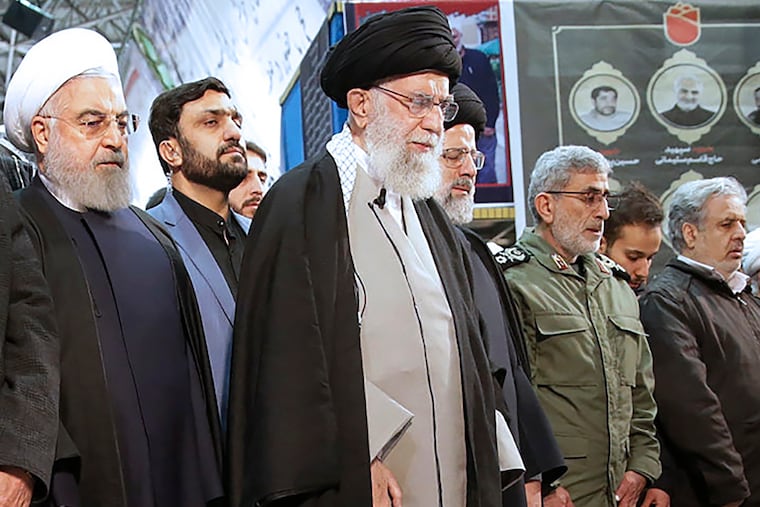Trump and Iran have paused confrontation, but the struggle hasn’t ended | Trudy Rubin
We are only in a lull before we enter Phase Two of the post-Soleimani "war.”

Watching President Trump give his Iran speech on Wednesday, my mind flashed back to a visit to Tehran just before the 2003 U.S. invasion of Iraq.
Senior Iranian officials were openly nervous — fearing they would be next after Saddam Hussein on America’s hit list. They spoke in whispers about the need for a deal with the U.S. A few weeks after the Iraq war began, Iranian reformers sent a message to Washington proposing a “grand bargain” in which everything was on the table: Iran’s support for terrorism, its nascent nuclear program, even its threats to Israel, in return for an end to sanctions and U.S. guarantees that ruled out regime change.
That overture was ignored, and President George W. Bush went on to denounce Iran as part of “the axis of evil.” Much has changed since then, with Iran’s nuclear program much further along and its regional power immensely enhanced since the failed 2003 war.
» READ MORE: After Soleimani death, what's the strategy? | Trudy Rubin
Yet I was listening for any inkling that Trump had interest in trying to leverage Qassem Soleimani’s killing into talks between Washington and Tehran. The hints were there, but the substance headed in a very different direction.
Which is one big reason why I believe we are only in a lull before we enter Phase Two of the post-Soleimani “war.”
Although both sides chose not to escalate militarily — with Iran apparently aiming retaliatory missiles so that they would avoid harming U.S. soldiers — new long-term battle lines are being drawn.
This is not a war in conventional terms. On Iran’s part, the paramount goal in Phase Two is to drive U.S. forces out of the region (which was Soleimani’s ultimate objective), thus enhancing their regional power. “What matters is that the presence of America … should come to an end,” Iran’s Supreme Leader Ayatollah Ali Khamenei told a crowd of clerics on Tuesday.
The Iranian effort will center first on squeezing Iraq to send American troops home. The Iraqi parliament — dominated by pro-Iranian Shiite factions — has already called, in a nonbinding vote, for U.S. forces to leave, but the final decision will be up to a weak acting prime minister, Adil Abdul-Mahdi. The pressure on him is huge.
Iran will no doubt task its proxy Shiite militias within Iraq to make it so difficult for U.S. forces to conduct their missions that they are largely confined to bases (without causing casualties). If American soldiers are forced out, Tehran will then dominate Iraq and Syria, and pro-Iranian militias will come to dominate Iraq’s army. Soleimani’s dream will have been achieved despite his death.
Trump’s goals are more contradictory. Although he made clear he doesn’t want another military conflict, he also repeated demands that Iran totally abandon its nuclear program and regional role.
Yet there was little sign, despite Soleimani’s death, that the White House had a new strategy to force Iran to obey, beyond the hope that the Tehran government will collapse from within.
However, there were intriguing hints in Trump’s speech that he is seeking cover to bring U.S. troops home from Iraq. (This was clearly indicated when a Pentagon letter to that effect was leaked this week, only to be retracted and described as just a draft.)
The president called on NATO allies, along with Russia and China (all signatories to the Iran nuclear deal from which he withdrew the United States) to “break away from remnants of the Iran deal.” And he said he would ask NATO “to be much more involved in the Middle East process.”
But those allies aren’t likely to join an ultra-hawkish U.S. effort that reeks of regime-change fantasies. Britain, France, and Germany were rudely rebuffed by Trump when they begged him to negotiate a follow-on nuclear deal with their help, while keeping the old deal in place.
Nor will NATO members, insulted so often by Trump, send more of their troops to Iraq to help him please his electoral base by bringing his troops home. Not when Trump refuses even to keep them in the loop when making key decisions in the region.
And forget about help from Moscow or Beijing.
» READ MORE: Bob Dylan would understand Trump foreign policy in 2019 | Trudy Rubin
So the president must decide. If he wants allies’ help, he will have to heed their concerns about a new nuclear deal. And if he wants to negotiate with Tehran (with chances slim to slimmer), he would need to send skilled diplomats to conduct backdoor diplomacy rather than set policy by tweet.
Moreover, however distasteful, he would have to convince Tehran that regime change was not his goal, and offer some sweeteners, such as sanctions relief, to get the regime on board.
In the meantime, he needs to stop insulting Iraqi leaders with threats to sanction them or charge for U.S. occupation bases. Instead he’d do well to figure out how to support Iraqi factions who don’t want to kick U.S. troops out.
Iran is playing a long game, a three-dimensional set of chess, which requires strategic thinking in the White House. Not the same kind of thinking required to play golf.